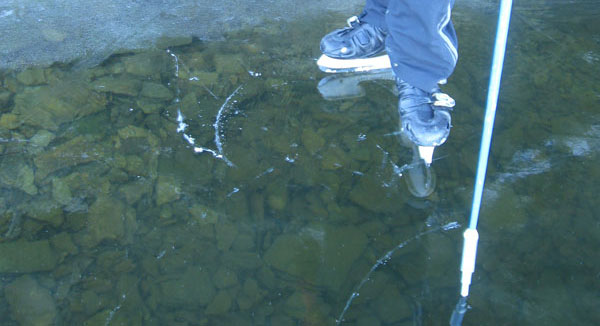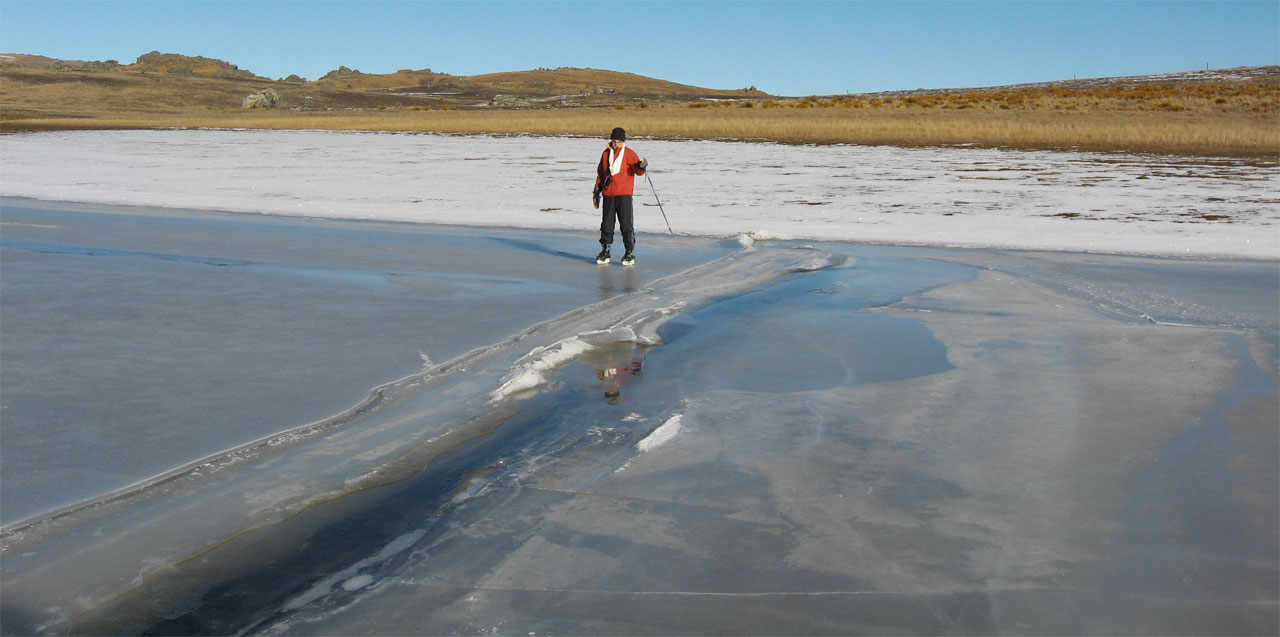Please be aware that skating outdoors on natural is ALWAYS dangerous. You do so at your own risk and you must be aware that there are inherent dangers in skating on frozen ponds, lakes or dams. The advice found on this page are to be used purely as a guide. It is imperative that you judge ice strength yourself and do not venture onto an ice surface if you are uncomfortable in your own judgement of the ice strength.
Golden rules
 The golden rules of natural ice skating are:
The golden rules of natural ice skating are:
- Never skate alone
- Always test ice before skating
- Always carry emergency equipment
- Always prepare for the worst
- Always have fun!
Handy documents
- Equipment to take with you
- Aardwolfs Ice Safety page
- Ice safety fact sheet
- North Dakota safety on ice
- eHow – Survive fall through ice
- Educational safety videos
Places to avoid
Natural ice surfaces are full of dangers. Here are some of the most common hazards you need to be aware of and know to be aware of:
- Shoreline – the shoreline often does not freeze well (or at all) due to the proximity of warming grasses, reeds and other plant life
- Hot springs – under ice hot springs can cause unexpected changes in ice thickness, or even leave sections of liquid water which must be avoided
- Moving water – ice on top of moving water is usually thinner than other ice and if you do fall through there is an increased risk of being sucked under the ice if the current is strong enough
- Sunny areas – as expected, areas of ice which receive more sun will typically be less thick/strong than other areas
- Groups of people – the more people in one area, the more force is exerted on the ice; the less people in one area the safer
- Debris – wood, plants and rubbish can all reduce the quality of ice and make it unsafe for skating
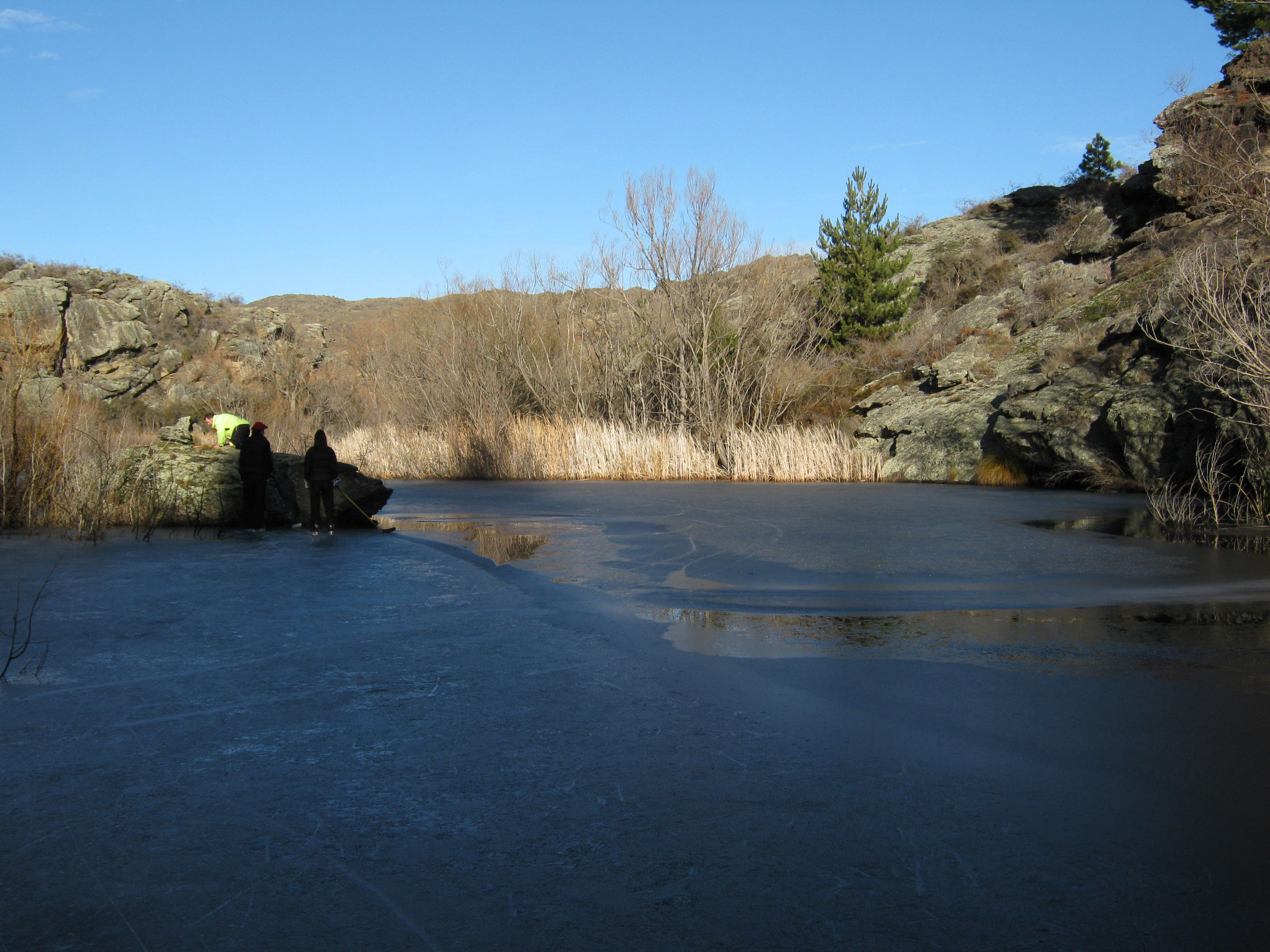
The neck at the Lower Manorburn dam is very hazardous as the total flow of the dam is funneled through a small section. Even when the rest of the dam is safe to skate, the increased water flow caused by the funneling effect in this one small section can cause the ice to be extremely thin and dangerous. Photo courtesy of Ryan Hellyer.
Cracking
It is common to hear the ice cracking. This is not necessarily a sign that the ice is dangerous, although the amount of cracking an pitch of the sound can be a useful measure of how safe the ice is to skate on. Very thick ice will crack less and be at a lower pitch than that of thin ice. Dangerously soft ice will usually not crack either because of it’s flexibility.
When skating on a fresh piece of ice it is common to hear extensive cracking the first few times you skate over it, but as the ice settles in, the cracking reduces.
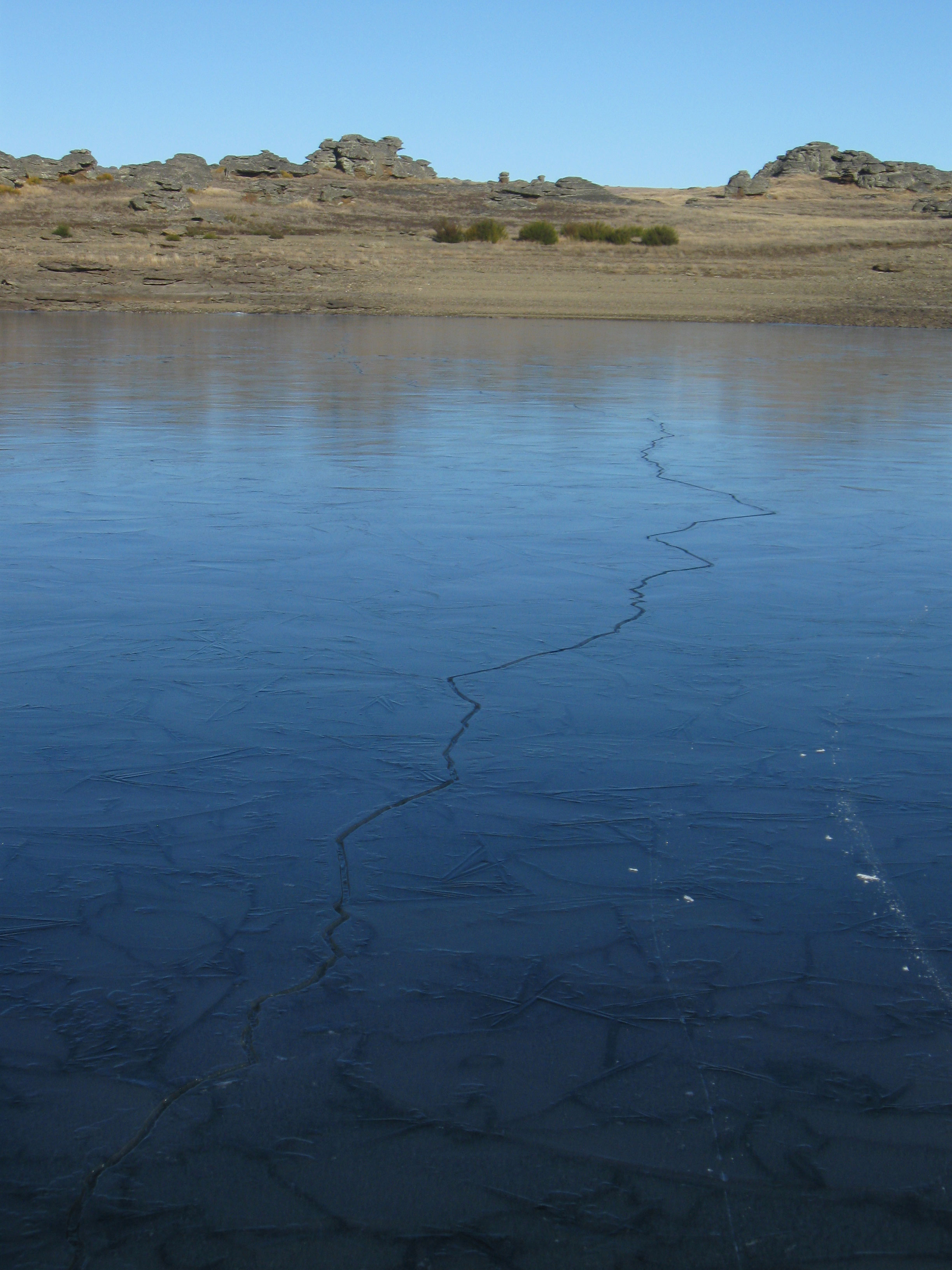
A large, but very safe crack on Poolburn reservoir. The ice at this point was over 100 mm thick and very strong. The gap between the two sections of ice in this crack is approximately 10 mm and the total length of the crack was over 300 m. Photo courtesy of Ryan Hellyer.
Ice testing
There are many different methods of testing ice before skating. The most common approach is to find a very shallow area and place one foot onto the ice, then apply your body weight until you feel comfortable to place your other foot onto the ice surface as well. At this point you may either drill a hole in the ice to check for ice thickness, although more experienced natural ice skaters are often comfortable with trusting the “feel” of the ice.
Once onto the ice surface, it is a good idea to check any new sections of ice which you skate on to ensure safety. This can be done via drilling holes through the surface.
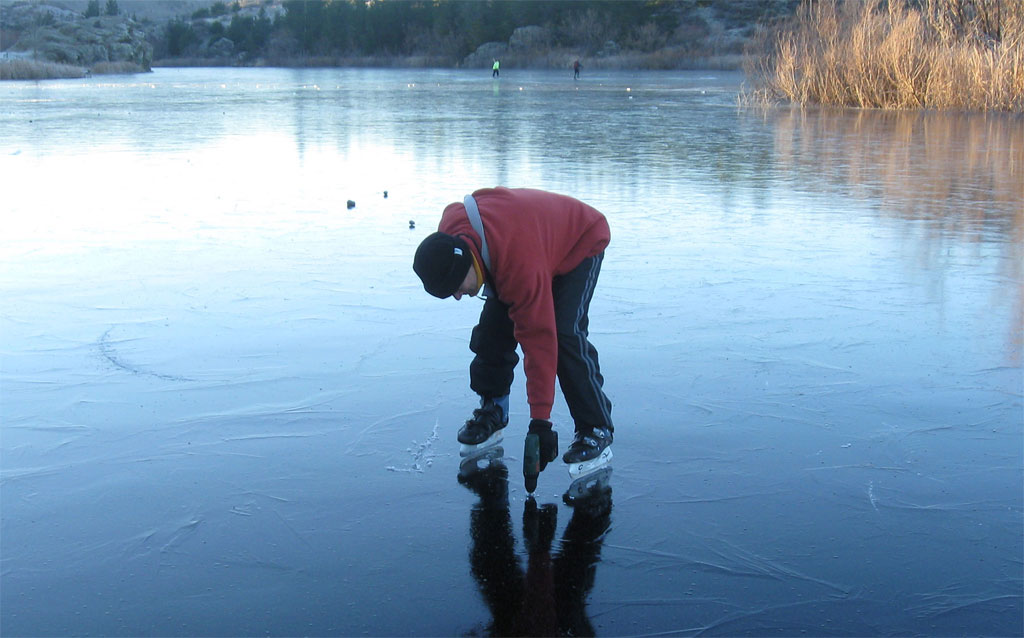
Dave Young drilling a hole into the Lower Manorburn dam to measure the ice thickness. You know the bottom of the ice has been reached because the drill pushes through to the other side and water flows back up through the hole. Photo courtesy of Ryan Hellyer.
An alternative method to checking ice integreity is to use a pole with a metal spike to skewer the ice . By skewering the ice, you can both feel the amount of force required to push through it and the cracks which form can be used to judge ice thickness. Please be wary of where and when you do this as other skaters may not appreciate you ramming holes through where they intend to skate. Skewering the ice also creates a risk of damaging the ice surface in a way that could cause you to fall in, so always skewer with care!
Ice types
Green ice
Green ice is commonly referred to as black ice, however green ice specifically refers to ice without no bubbles or embedded snow. Green ice is the strongest, safest and most pleasant type of ice to skate on. Green ice is most commonly found in shaded areas, in particular under rock overhangs where snow can not reach it or where snow is blown away from the ice surface.
Black ice
Not to be confused with green ice, black ice refers to ice which appears black or dark grey in colour due to it being transparent. Unlike green ice, black you can not see clearly through black ice due to imperfections in the ice, bubbles, debris etc. Black is the second strongest and safest type of ice to skate on and is almost as good to skate on as green ice, particularly if the top layer has melted and refrozen.
Refrozen ice
Refrozen ice consists of chunks of broken ice which have thawed and then refrozen back together again. This can either lead to a very strong ice, almost as strong as black ice, or very weak ice if the edges of each chunk do not bond properly.

Refrozen ice at Poolburn reservoir. From left to right: David Patchett, Alan Knowles and Dave Young. Photo courtesy of Ryan Hellyer.
Snow ice
Snow ice consists of snow which has frozen into a solid layer. Snow ice can be reasonably strong and good to skate on if there is a thaw followed by a refreeze, but otherwise can be very difficult to skate on and due to the softness and flexibility of the surface can be be very dangerous. Due to the difficulty in seeing through snow ice it is difficult to know how thick the ice is beneath you without manually testing the ice with a skewer or drill. If there is a thick crust of ice you need to be careful of imperfections which may trip you, or in extreme circumstances stop you dead in your tracks.
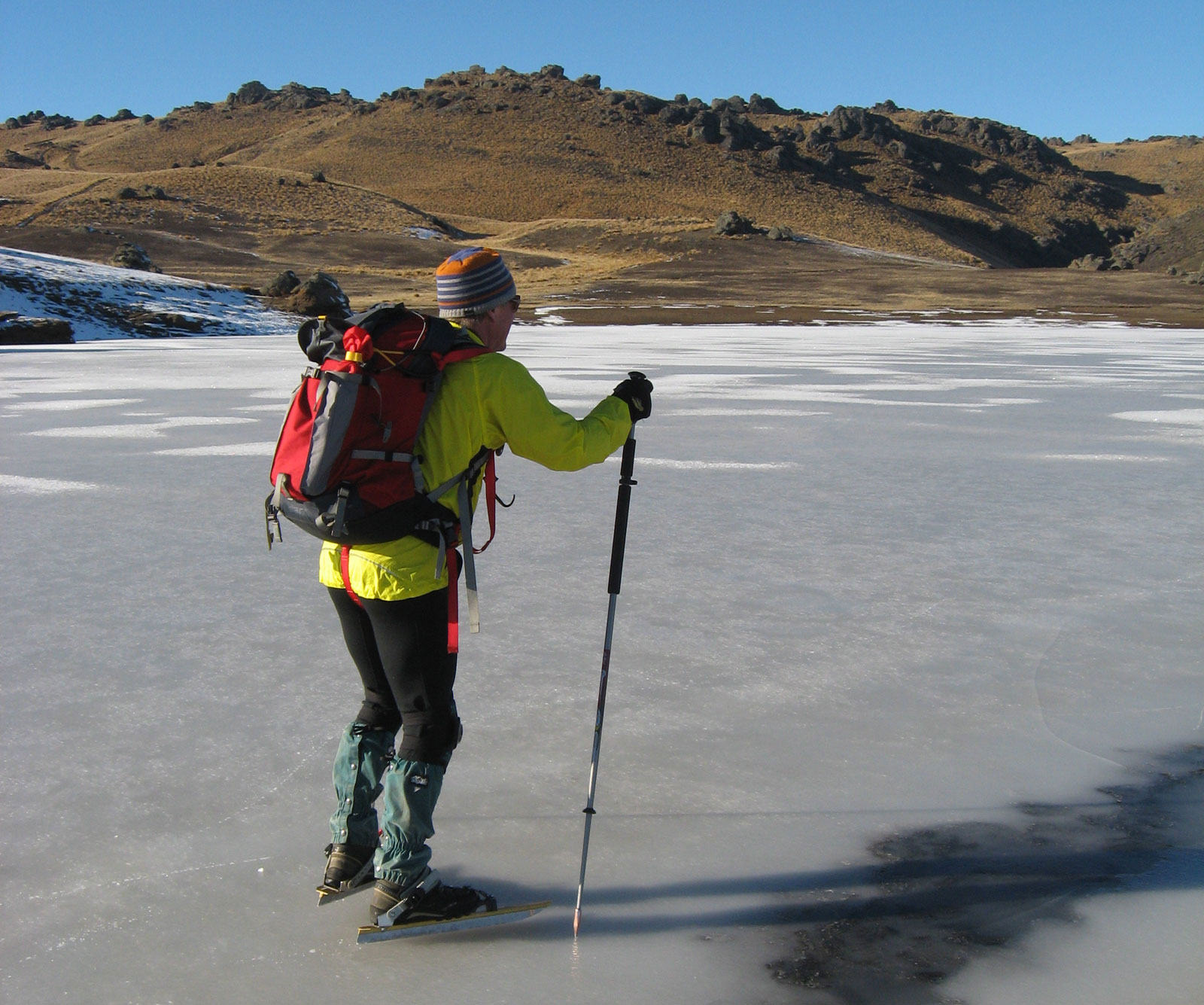
Alan Knowles skating on snow ice on Poolburn reservoir. The erratic fall and blowing of snow across the surface can lead to rapidly changing ice conditions and safety from place to place. Photo courtesy of David Patchett.
Getting onto the ice
Sometimes the shoreline around a patch of ice may be totally molten. It is not recommended to skate on ice which is surrounded by water, as it is a good sign that the ice surface itself is not very safe. However, if you just can’t control your urge to skate and have taken sufficient safety precautions then you can attempt to reach the ice surface either through wading through the icy cold water or by building a small bridge either via a plank of wood or a ladder.
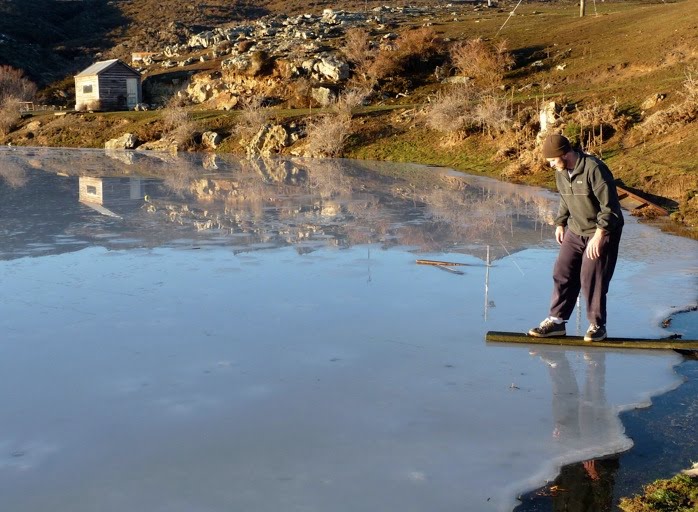
Dave Patchett making his way onto the ice surface of the Idaburn dam. Never attempt this without taking full safety precautions. Photo courtesy of Dave Young.
Ice thickness
Ice thickness on it’s own is not a reliable method of determining ice strength, however combined with analysing the type of ice it can be a useful way to help determine ice safety.
There is no definite measure of how thick ice must be before it can be skated on, however it is generally considered technically possible to skate on ice as thin as 25 mm thick as long as it is high quality green or black ice with few imperfections. Skating on ice that thin is very unwise however as any change in ice thickness or strength or a fall onto the ice would likely cause the ice to break. Most skaters will not skate on anything less than 60 mm thick green or black ice, or 100 mm thick snow ice. Never trust ice thickness as an accurate marker for ice strength though. Soft, slushy 120 mm thick ice can be considerably less safe than 40 mm thick green ice.
For an excellent demonstration of how very thin ice behaves when skated on, visit our “Waves under the ice post“.
Depth
Some ponds and irrigation dams may be very shallow, which greatly improves safety as you may not need to worry about drowning if the water is less deep than you are tall. However it is important to remember that the water depth may be considerably above your own height and so you will not just be able to step back up onto the ice if something goes catastrophically wrong.
To measure the depth of the water, you can drill a small hole and drop a line of string or fishing line down with a small weight on it. Drop the line down the hole, and when it reaches the bottom you can pull it back up and measure the distance it dropped.

David Patchett demonstrating the depth of Poolburn reservoir to the Killer Keas ice hockey team. Photo courtesy of Ryan Hellyer.
Gaps in ice
It is always important to remain on the outlook for potential gaps in the ice or unexpected thin or soft areas. It is not uncommon for an area of ice to be very strong all the way across a dam or pond, but there still be small pockets of extremely weak ice or even water. This is particularly common when small springs under the ice cause localised melting. Other causes of rapid changes in ice strength are small currents, pressure cracks, streams flowing from a hillside or vegetative decomposition under the ice (releases methane which can potentially weaken/melt the ice).
For a good example of a dangerous gap in the ice, please visit our “Gap in ice on Poolburn” post.
Falling through
If you fall through the ice, it is imperative to get out as quickly. Stay calm, and if you have them, remove your ice claws from their protective casing. The most common approach is to place your arms back up onto the ice, then either kick with your feet and pull yourself back out. If this does not work, either because you can’t get enough leverage or grip on the ice, then you can try floating your legs up alongside the ice and rolling over so that your legs go up onto the ice surface. Once out of the water, do not stand back up as you will likely fall through again, drag yourself along the ice until you reach a stronger section which will support your weight.
If you are close to the shore/car, then skate back immediately and get changed in the car (with the heaters on full tack!), otherwise remove your rubber pad from your pack and stand on it while undressing yourself, then dry yourself down, put your spare set of clothes on and then skate/jog back to the car as quickly as possible to warm yourself up again.
If you should fall in and move under the ice the only way to break the ice from under it is to try kicking it with your skates, work really hard to never have to try this.*
If you see someone fall through, the best approach to getting them out is to throw your safety rope to them from as far a distance away as possible. Once out of the water, help them get changed, dried and warmed up as soon as possible.
Want to contribute?
If you would like to contribute to this page, please get in touch, or apply to be an official contributor to the site.
